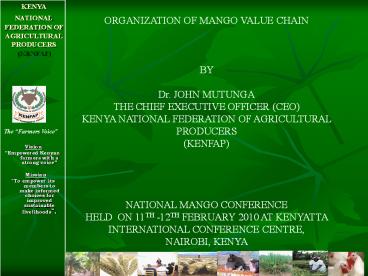KENYA NATIONAL FEDERATION OF AGRICULTURAL PRODUCERS - PowerPoint PPT Presentation
1 / 20
Title: KENYA NATIONAL FEDERATION OF AGRICULTURAL PRODUCERS
1
Vision ''Empowered Kenyan farmers
with a strong voice Mission "To empower
its members to make informed choices for improved
sustainable livelihoods".
KENYA NATIONAL FEDERATION OF AGRICULTURAL
PRODUCERS(KENFAP)
ORGANIZATION OF MANGO VALUE CHAIN BY Dr.
JOHN MUTUNGA THE CHIEF EXECUTIVE OFFICER
(CEO) KENYA NATIONAL FEDERATION OF AGRICULTURAL
PRODUCERS (KENFAP) NATIONAL MANGO
CONFERENCE HELD ON 11TH -12TH FEBRUARY 2010 AT
KENYATTA INTERNATIONAL CONFERENCE CENTRE,
NAIROBI, KENYA
The Farmers Voice
2
KENFAP
- Umbrella farmers organization
- Farmers Voice in Kenya
- Represents over 1.5 million farm families
location -National - Membership categories
- Farmers groups-5,000
- Commodity association-24,
- Cooperative societies - 11
- Large scale farms- 5
- Represents interest of livestock, crops and
community forest among others - Majority are smallholder farmers
- Kenya Mango Producers and Marketing Association
is a member
3
KENFAP vision mission
- Vision
- Empowered Kenyan farmers with a strong voice
- Mission
- "To empower its members to make informed choices
for improved sustainable livelihoods". - Mango value chain development is inline with
KENFAP vision mission
4
Mango as an economic undertaking
- Mango is tropical fruit grown in all the
provinces in Kenya - Many varieties Suited to altitudes ranging from
0 1900 m above sea level - Produced both for commercial and home
consumption. - Production is influenced by altitude and rainfall
- Use as Food, fuel,
- Source of income livelihood of the rural areas
- Cash crop for ASALs
- Foreign exchange earner through export
- The potential not fully utilized due poor
organization
5
Who produces mangoes?
- KENFAP/GTZ/PSDA study past studies
- Smallholder farmers
- 50-60
- Using local low yielding varieties.
- Large commercial farms
- 25-35
- Others 5
6
Organization of the value chain
- Players at different levels
- Farmer - Growers, nursery operators, workers,
inputs suppliers - Marketing traders, transporters, exporters,
middlemen/broker, retailers, wholesaler,
supermarkets, clearing agents, tax collectors - Processing-technology, quality assurance
- Support services
- Research
- Extension
- Education
- Finance
- Environment
7
Farmers
- Present scenario
- Organized
- Groups/associations/coops
- Contracts/negotiated prices
- Legally binding agreed terms
- Improved varieties-KARI
- Certification -KEPHIS
- High yields early mature
- Value addition at farm
- Economies of scale
- Coordination monitoring
- Individual
- Price takers
- Flexible prices
- Use local varieties
- Low yields
- Huge losses and wastage
- High cost of inputs
- Mango marketed in raw form
- Disorganized
8
Markets
- Present scenario
- Organized
- Farm gate- middlemen
- Transit-damage, mode, time, roads
- Local market-survival for the fittest,
facilities, CESS - Market information-poor
- Export-quality, losses, infrastructure, capacity
- Consumer-distance, taste,
- Collection centres
- Refrigerated vehicles
- Fresh produce markets
- Weights measures-monetary value /per unit
- Market information network
- Quality assurance-KEBS/EU
- Traceability
9
Processors
- Present scenario
- Organized
- Raw material-quality, seasonality
- Equipment technology gap, imported, skills
- Handling storage, preservation
- Value addition- dried
- Standards- packaging,
- Consumers food safety
- Reliable consistent supply
- Appropriate equipment, available affordable
- Cooling plants
- Certification-KEBS
- Labeling-ingredients
- Branding
- Quality mark
10
Support services
- Present scenario
- Organized
- improved varieties, strengthen farmer-researcher
linkages - Establish a consultative forum
- Demand driven information network
- University - advance farmer innovations
,curriculum - Farmers revolving fund/schemes
- Policy
- Research local varieties, linkages
- Extension weak information sharing and
dissemination - Education- disconnect , knowledge generation
- Finance packaging, costs, relevance-extra
ordinary profits - Environment no mango/horticulture policy
11
Why organize mango value chain
- Create harmony among different players
- Build synergies
- Balance competing interests
- Make choices and network
- Benefit sharing
- Embrace economies of scale
- Make work easier
12
The Critical Areas of organization
- KENFAP/GTZ/PSDA study past studies
- Organization of producers- Determinants
- Smallholder farmers
- Large scale farmers
- Companies
- Institutions
- Others
- Organization of market agents-Prime movers
- Organization of working environment-
Facilitators - Government-policy, regulation, research
(varieties), extension (information) - Organization of private investments-infrastructure
joint ventures - Operation of markets-Fresh produce retail
wholesale markets
13
Priority to trigger Organization
- Organize smallholder farmers as determinants of
robust mango value chain - Maximize collective action in
- Pre production
- Production
- Marketing process
- Standardization
- Value addition
- Export
- Traceability
14
Why emphasis on organization of smallholder
farmers
- Organization process
- Organization indicators
- Representation
- Participation/collaboration
- Accountability
- Strategic potential
- Professional capacity
- Gender policy
- Income diversification
- Organizational degree
- Build strong farmers organization
- Recruitment of members
- Legal registration
- ID/OS
- Strategic orientation
- Strategic objectives
- Work plan
15
Conclusion
- Increasing mango production and productivity is
paramount - It is imperative to organize producers to trigger
actions from other players - Development of quality and high yielding
varieties is extremely important - Good policy environment guides Investments and
development of the value chain
16
Recommendations
- Amply the ongoing initiatives
- Strengthening of Kenya Mango Producers and
Marketing Association - Strengthening of Nursery Operators Association
- Fast tracking activities of Horticulture
taskforce - Fast track formulation of Horticulture policy
- Intensify development of quality and high
yielding varieties - Fast track establishment of fresh produce retail
wholesale markets - Organize smallholder farmers into economic units
to unlock potential through productive
engagements - Set up a steering team to oversee mango value
chain development
17
Mangoes in a market stall in Netherlands
18
Price is 1.99Euroskshs 200.00
19
Value of organization
- A shift from a price of kshs 5.00 for one mango
sold at a local open air market in Kenya to an
equivalent price of kshs 200.00 of similar mango
sold at a supermarket in Europe - Means a transformation of 4,000
- Is it possible?
20
THANK YOU































